View Device Logs
The 'Logs' tab shows all events that occurred on a specific device. This contrasts to 'Dashboards' > 'Dashboards' > 'Audit Logs', which shows events on all devices.
View device logs
-
Click 'Assets' > 'Devices' > 'Device List'
-
Click the 'Device Management' tab
Select a group to view just its devices
OR
Select 'Show all' to view every device enrolled to Xcitium
-
Click the name of a Windows device
-
Click the 'Logs' tab

There are eight types of logs, each shown on a different tab. Each row on these tabs is a specific event.
-
The first column shows the template that caused the log to be generated. This is a named monitor, procedure or discovery task.
-
You can manage these templates in 'Configuration Templates' > 'Alerts' > 'Procedures' / 'Monitors'
-
The 'Alert Logs' tab has a slightly different layout. The template is shown in the 'Trigger Name' column
-
The last column, 'Details', shows the contents of the log. Click this to view all steps that occurred in the event.
-
Again, this is slightly different in the 'Alert Logs' tab. 'Details' is replaced with 'Hit Count'.
-
Each row represents a different event. For example, event logs are created when:
A procedure fails
A condition is breached in a monitor
An alert is generated on the device
A script or patch procedure is executed
An app from the 'Windows Application Store' is installed
An OS update is installed or uninstalled
A network discovery scan is run
Click on the following for details about each type of log:
A record of all events where an alert was generated on the endpoint. For example, logs are generated after a failed procedure deployment or a breach of monitoring conditions.
-
Click 'Assets' > 'Devices' > 'Device List'
-
Click the 'Device Management' tab
Select a group to view just its devices
Or
Select 'Show all' to view every device enrolled to Xcitium
-
Click the name of the Windows device then select the 'Logs' tab
-
Select 'Alert Logs'

|
Alert Logs - Table of Column Descriptions |
|
|---|---|
|
Column Heading |
Description |
|
Alert Name |
The alert template used in the event.
|
|
Trigger Name |
The monitor or procedure that generated the alert.
|
|
Trigger Type |
Can be 'Monitor' or 'Procedure' as explained above. |
|
Hits Count (24 H Period) |
The number of time this condition was triggered in the past 24 hours. |
View Monitoring Logs
-
Monitors are procedures which keep track of specific items on an endpoint. For example, you may set a monitor to track disk usage does not exceed a certain percentage.
-
Monitors can be added to the 'Monitoring' section of a configuration profile
-
Logs are shown for the past 24 hours.
See Manage Monitors for help to create monitors.
See Monitor Settings for help to add monitors to profiles
View monitoring logs
-
Click 'Assets' > 'Devices' > 'Device List'
-
Click the 'Device Management' tab
Select a group to view just its devices
Or
Select 'Show all' to view every device enrolled to Xcitium
-
Click the name of the Windows device then select the 'Logs' tab
-
Click 'Monitoring Logs'

|
Monitoring Logs - Table of Column Descriptions |
|
|---|---|
|
Column Heading |
Description |
|
Monitor Name |
The monitoring condition that was triggered to create the log.
|
|
Status |
Whether or not the monitor is currently active on the device. |
|
Hit Count |
The number of times the monitoring condition was breached during the last 24 hours. |
|
Last Hit Time |
Date and time the monitoring rule was last broken. |
|
Last Update Time |
Date and time when the information was last refreshed. |
|
Details |
|
View
Details of Monitoring Logs
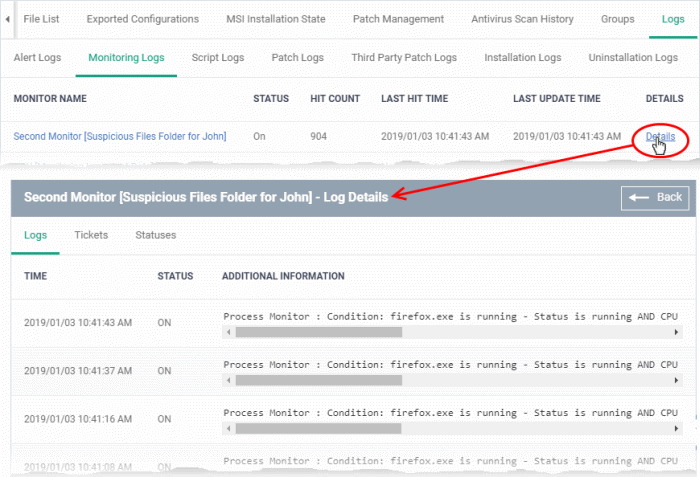
Details are shown under three tabs:
Logs- The date and time when the event occurred. Also shows details about the monitoring rule that detected the event.
|
Monitoring Log Details - 'Logs' tab - Table of Column Descriptions |
|
|---|---|
|
Column Heading |
Description |
|
Time |
Date and time of the event. |
|
Status |
The current status of the monitored condition on the device. |
|
Additional Information |
Details on the condition monitored and the breach |
Tickets - Shows any service
desk tickets created by the events. Applies only to Xcitium products
with Service Desk.
Statuses- Shows the current status of all conditions monitored on the device.
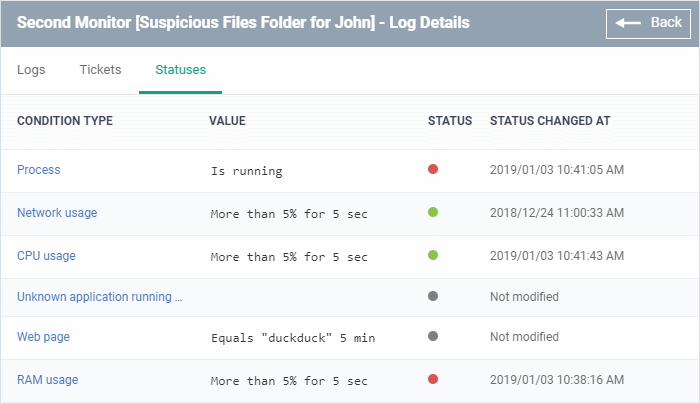
|
Monitoring Log Details - 'Statuses' tab - Table of Column Descriptions |
|
|---|---|
|
Column Heading |
Description |
|
Condition Type |
The observed parameter of the monitor. Click the condition to view the details of the monitored parameter and configured thresholds. An example is shown below:
|
|
Value |
The thresholds set for the parameter. |
|
Status |
Current state of the monitored parameter.
|
|
Status Changed at |
The date and time of the most recent change to the monitor status. |
-
The 'Script Logs' tab shows script procedures that were manually run on Windows devices as well as those run automatically via a profile.
-
For more details on creating and running script procedures, see Manage Procedures.
View script procedures logs
-
Click 'Assets' > 'Devices' > 'Device List'
-
Click the 'Device Management' tab
Select a group to view just its devices
Or
Select 'Show all' to view every device enrolled to Xcitium
-
Click the name of the Windows device then select the 'Logs' tab
-
Click 'Script Logs'
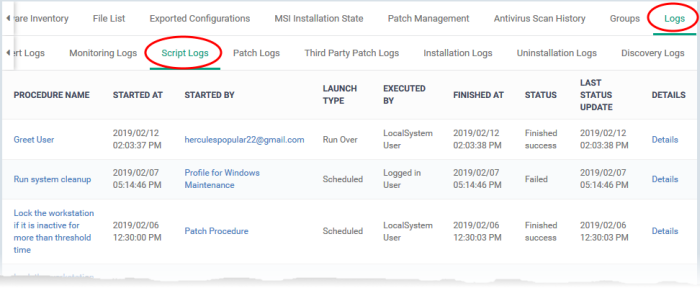
|
Script Procedure Logs - Table of Column Descriptions |
|
|---|---|
|
Column Heading |
Description |
|
Procedure Name |
The label of the script procedure that was run on the device.
|
|
Started At |
The date and time when the procedure commenced. |
|
Started By |
Who or what launched the procedure.
|
|
Launch Type |
Whether the procedure was scheduled or run manually. |
|
Executed By |
The user account type used by Xcitium to execute the procedure. |
|
Finished At |
The date and time when the procedure was completed. |
|
Status |
Whether the script successfully executed or not. You can configure an alert if a procedure deployment fails. See 'Manage Procedures' for more details. |
|
Last Status Update |
The date and time when the information was last updated. |
|
Details |
|
View Script Procedure Log details

The details are displayed under two tabs:
Statuses- The date and time at which successive stages in the procedure were run, their success status and results.
|
Script Procedure Log Details - 'Statuses' tab - Table of Column Descriptions |
|
|---|---|
|
Column Heading |
Description |
|
Time |
The date and time of the procedure execution. |
|
Status |
Whether the execution was successful or not. |
|
Additional Information |
Provides details on the execution:
|
Tickets - Shows any service desk tickets created by the events. Applies only to Xcitium products with Service Desk.
-
The 'Patch Logs' tab shows OS patch procedures that were manually run on Windows devices as well as those run automatically via a profile.
-
For more details on creating and running patch procedures, see Manage Procedures.
View patch procedures logs
-
Click 'Assets' > 'Devices' > 'Device List'
-
Click the 'Device Management' tab
Select a group to view just its devices
Or
Select 'Show all' to view every device enrolled to Xcitium
-
Click the name of the Windows device then select the 'Logs' tab
-
Click 'Patch Logs'
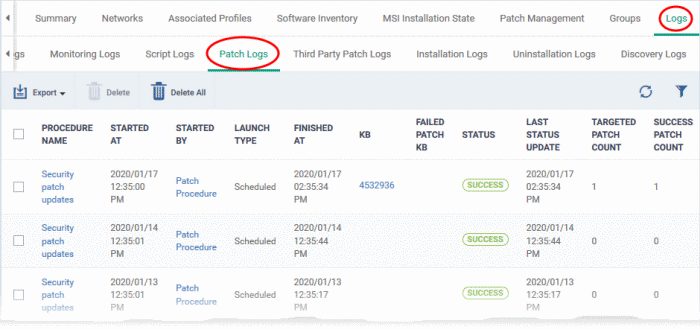
|
Column Heading |
Description |
|---|---|
|
Procedure Name |
The label of the patch procedure that was run on the device.
|
|
Started At |
The date and time when the procedure commenced. |
|
Started By |
Who or what launched the procedure.
|
|
Launch Type |
Whether the procedure was scheduled or run manually. |
|
Finished At |
The date and time when the procedure was completed. |
|
KB |
Microsoft knowledgebase articles for successfully deployed patches.
|
|
Failed Patch KB |
Microsoft knowledgebase articles for patches whose deployment failed.
|
|
Status |
Whether the OS patch procedure was successfully executed or not. You can configure an alert if a procedure deployment fails. See 'Manage Procedures' for more details. |
|
Last Status Update |
The date and time when the information was last updated. |
|
Targeted Patch Count |
Total number of patches included in the procedure. |
|
Success Patch Count |
|
| Fail Patch Count |
|
|
Details |
|
View OS Patch Procedure Log details
Click the 'Details' link to view details about a procedure's execution:

The details are displayed under two tabs:
Statuses- The date and time at which successive stages in the procedure were run, their success status and results.
|
OS Patch Procedure Log Details - 'Statuses' tab - Table of Column Descriptions |
|
|---|---|
|
Column Heading |
Description |
|
Time |
Date and time of the procedure execution. |
|
Status |
Whether the execution was successful or not. |
|
Additional Information |
Provides details on the execution:
|
Tickets - Shows any Service Desk tickets raised for any failed procedures. Applies only to Xcitium products with Service Desk.
View Third Party Patch Procedure Logs
-
The third-party patch tab shows logs of patch deployments run on third party applications.
-
This includes procedures that were run manually and those run automatically via a profile.
-
If you need help to create patch procedures, see Manage Procedures.
View third party patch procedures logs
-
Click 'Assets' > 'Devices' > 'Device List'
-
Click the 'Device Management' tab
Select a group to view just its devices
Or
Select 'Show all' to view every device enrolled to Xcitium
-
Click the name of the Windows device then select the 'Logs' tab
-
Click 'Third Party Patch Logs'

|
Third Party Patch Logs - Table of Column Descriptions |
|
|---|---|
|
Column Heading |
Description |
|
Procedure Name |
The label of the procedure that was run on the device.
|
|
Started At |
The date and time when the procedure commenced. |
|
Started By |
Who or what launched the procedure.
|
|
Launch Type |
Indicates whether the procedure was scheduled or run manually. |
|
Finished At |
The date and time when the procedure was completed. |
|
Status |
Whether the third party patch procedure was successfully executed or not.
|
|
Last Status Update |
Date and time when the information was last updated. |
|
Details |
|
View Third Party Patch Procedure Log details
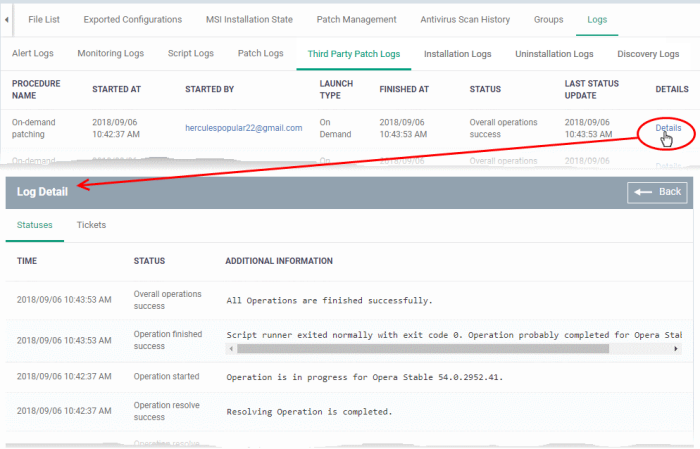
The details are displayed under two tabs:
Statuses- The date and time at which successive stages in the procedure were run, their success status and results.
|
Third Party Patch Log Details - 'Statuses' tab - Table of Column Descriptions |
|
|---|---|
|
Column Heading |
Description |
|
Time |
Date and time of the procedure execution. |
|
Status |
Whether the execution was successful or not. |
|
Additional Information |
Provides details on the execution:
|
Tickets - Shows tickets raised for any failed procedures. Applies only to Xcitium products with Service Desk.
-
Xcitium lets you remotely install third-party applications on to managed Windows devices from its Windows application store. This feature will be added in future versions.
-
The 'Installation Logs' tab shows installations of third party applications from the Windows application Store ('Application Store' > 'Windows Application Store').
View Uninstall Logs
-
The uninstallation tab contains logs about the removal of third party applications from devices.
There are two ways in which you can remotely uninstall applications:
-
'Device Details' interface - You can uninstall selected application(s) from an individual device.
Click 'Assets' > 'Devices' > 'Device List' > 'Device Management'
Click the name of a Windows device and select the 'Software Inventory' tab
Select the applications and click 'Uninstall Selected Application' on the top
See View and Manage Applications Installed on a Device for more details
-
'Global Software Inventory' interface - You can uninstall selected application(s) from all managed devices on which the are currently installed.
Click 'Software Inventory' > 'Applications' > 'Global Software Inventory'
Select the application to be uninstalled
Click 'Uninstall' on the top
See View and Manage Applications Installed on Windows Devices for more details
-
Click 'Assets' > 'Devices' > 'Device List'
-
Click the 'Device Management' tab
Select a group to view just its devices
Or
Select 'Show all' to view every device enrolled to Xcitium
-
Click the name of the Windows device then select the 'Logs' tab
-
Click 'Uninstallation Logs'

|
Uninstallation Logs - Table of Column Descriptions |
|
|---|---|
|
Column Heading |
Description |
|
Procedure Name |
The possible value is 'On-demand Uninstallation'. You can uninstall apps from devices by two ways explained above. |
|
Started At |
The date and time when the uninstallation commenced. |
|
Started By |
The administrator who started the remote uninstallation.
|
|
Launch Type |
Indicates whether the procedure was scheduled or run manually. The possible value is 'On Demand' |
|
Finished At |
The date and time when the uninstallation was completed. |
|
Status |
Whether the remote uninstallation was successful, in progress, or failed. |
|
Last Status Update |
The date and time when the information was last refreshed. |
|
Details |
|
View Details of Uninstallation Logs
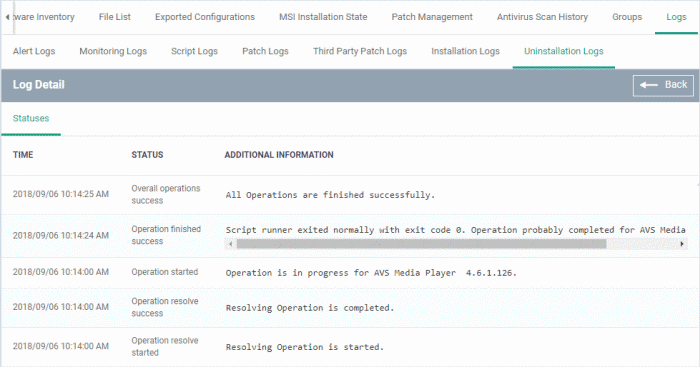
The 'Log Details' pane shows the date and time at which successive stages in the uninstallation were run, their success status and results.
|
Installation Log Details - 'Statuses' tab - Table of Column Descriptions |
|
|---|---|
|
Column Heading |
Description |
|
Time |
Date and time each stage in the uninstallation was run. |
|
Status |
Whether the execution was successful or not. |
|
Additional Information |
Show current installation progress.
|
- Xcitium lets you run discovery scans on your network to identify managed and unmanaged devices including SNMP devices, You can use any managed windows as probe device to run the scan.
- If a device has been used as a probe, then the discovery logs tab shows any scans run from it.
- See Create and Run Network Discovery Tasks if you want to learn more about discovery scans and probe devices.
- Click 'Devices' > 'Device List'
- Click the 'Device Management' tab in the top-menu
- Select a company or a group to view just their devices
Or
- Select 'Show all' to view every device enrolled to Xcitium Enterprise
- Click the name of the Windows device then select the 'Logs' tab
- Click 'Discovery Logs'
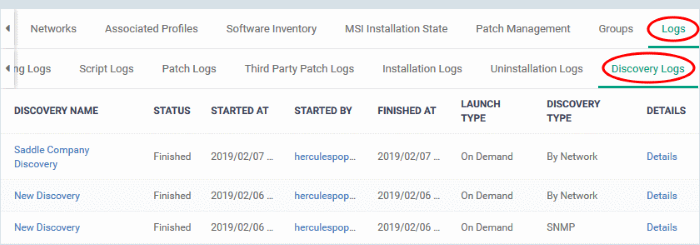
|
Discovery Logs - Table of Column Descriptions |
|
|---|---|
|
Column Heading |
Description |
|
Discovery Name |
The label of the discovery scan task.
|
|
Status |
Whether the scan is progress, queued or finished. |
|
Started At |
Date and time the scan commenced on the network. |
|
Started By |
The email address of the admin who launched the scan.
|
|
Finished At |
The date and time the scan ended. |
|
Launch Type |
How the scan was started. For example, 'On Demand' means it was manually started by an admin. |
|
Type of Discovery |
Can be SNMP scan or network (IP) scan. |
|
Details |
|
View Details of a Discovery Scan
- Click 'Details' in the row of a scan to view additional information:

- 'Click here' link - View devices found by the scan.
- See Discovered Devices for more details




